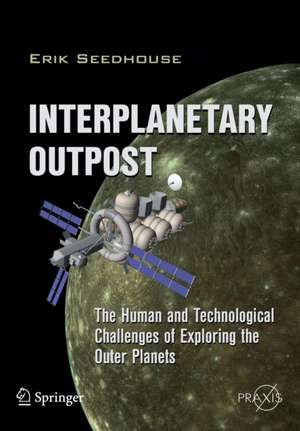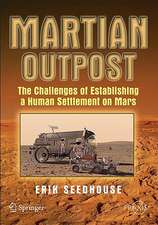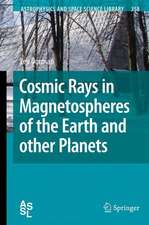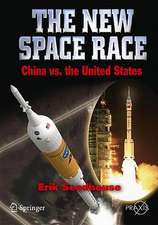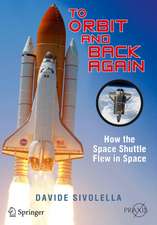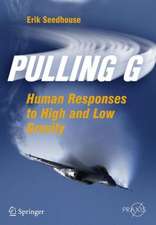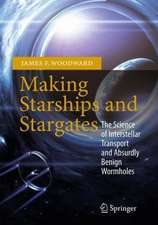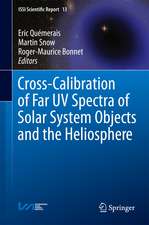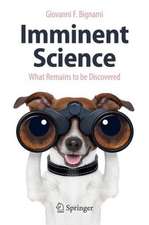Interplanetary Outpost: The Human and Technological Challenges of Exploring the Outer Planets: Springer Praxis Books
Autor Erik Seedhouseen Limba Engleză Paperback – dec 2011
Din seria Springer Praxis Books
-
 Preț: 294.46 lei
Preț: 294.46 lei -
 Preț: 223.45 lei
Preț: 223.45 lei -
 Preț: 193.12 lei
Preț: 193.12 lei -
 Preț: 167.85 lei
Preț: 167.85 lei -
 Preț: 288.98 lei
Preț: 288.98 lei -
 Preț: 323.74 lei
Preț: 323.74 lei -
 Preț: 401.38 lei
Preț: 401.38 lei -
 Preț: 264.12 lei
Preț: 264.12 lei - 8%
 Preț: 513.00 lei
Preț: 513.00 lei -
 Preț: 190.01 lei
Preț: 190.01 lei -
 Preț: 218.16 lei
Preț: 218.16 lei -
 Preț: 312.06 lei
Preț: 312.06 lei - 17%
 Preț: 414.05 lei
Preț: 414.05 lei -
 Preț: 216.41 lei
Preț: 216.41 lei -
 Preț: 262.27 lei
Preț: 262.27 lei -
 Preț: 264.35 lei
Preț: 264.35 lei -
 Preț: 167.63 lei
Preț: 167.63 lei -
 Preț: 284.81 lei
Preț: 284.81 lei -
 Preț: 259.08 lei
Preț: 259.08 lei -
 Preț: 305.47 lei
Preț: 305.47 lei -
 Preț: 244.14 lei
Preț: 244.14 lei -
 Preț: 227.85 lei
Preț: 227.85 lei -
 Preț: 285.25 lei
Preț: 285.25 lei -
 Preț: 295.56 lei
Preț: 295.56 lei -
 Preț: 357.17 lei
Preț: 357.17 lei -
 Preț: 275.79 lei
Preț: 275.79 lei -
 Preț: 257.08 lei
Preț: 257.08 lei -
 Preț: 349.71 lei
Preț: 349.71 lei -
 Preț: 272.45 lei
Preț: 272.45 lei -
 Preț: 270.27 lei
Preț: 270.27 lei - 8%
 Preț: 456.51 lei
Preț: 456.51 lei -
 Preț: 352.34 lei
Preț: 352.34 lei - 8%
 Preț: 394.80 lei
Preț: 394.80 lei -
 Preț: 320.65 lei
Preț: 320.65 lei -
 Preț: 325.29 lei
Preț: 325.29 lei -
 Preț: 253.11 lei
Preț: 253.11 lei -
 Preț: 192.86 lei
Preț: 192.86 lei -
 Preț: 313.40 lei
Preț: 313.40 lei -
 Preț: 150.51 lei
Preț: 150.51 lei -
 Preț: 233.34 lei
Preț: 233.34 lei -
 Preț: 286.78 lei
Preț: 286.78 lei -
 Preț: 212.01 lei
Preț: 212.01 lei -
 Preț: 366.83 lei
Preț: 366.83 lei -
 Preț: 299.99 lei
Preț: 299.99 lei -
 Preț: 232.27 lei
Preț: 232.27 lei -
 Preț: 284.58 lei
Preț: 284.58 lei -
 Preț: 212.45 lei
Preț: 212.45 lei -
 Preț: 159.81 lei
Preț: 159.81 lei -
 Preț: 349.48 lei
Preț: 349.48 lei - 20%
 Preț: 2061.64 lei
Preț: 2061.64 lei
Preț: 255.97 lei
Nou
Puncte Express: 384
Preț estimativ în valută:
48.99€ • 50.95$ • 40.44£
48.99€ • 50.95$ • 40.44£
Carte disponibilă
Livrare economică 24 martie-07 aprilie
Preluare comenzi: 021 569.72.76
Specificații
ISBN-13: 9781441997470
ISBN-10: 1441997474
Pagini: 284
Ilustrații: XXVIII, 253 p. 84 illus., 75 illus. in color.
Dimensiuni: 168 x 240 x 15 mm
Greutate: 0.48 kg
Ediția:2012
Editura: Springer
Colecția Springer
Seriile Springer Praxis Books, Space Exploration
Locul publicării:New York, NY, United States
ISBN-10: 1441997474
Pagini: 284
Ilustrații: XXVIII, 253 p. 84 illus., 75 illus. in color.
Dimensiuni: 168 x 240 x 15 mm
Greutate: 0.48 kg
Ediția:2012
Editura: Springer
Colecția Springer
Seriile Springer Praxis Books, Space Exploration
Locul publicării:New York, NY, United States
Public țintă
Popular/generalCuprins
Potential destinations.- Mission objectives.- Mission architecture.- VASIMR: the radical rocket.- HOPE hardware.- Descent and landing.- Selecting and training an interplanetary crew.- Biomedical and behavioral aspects of traveling to Callisto.- Voyage to Callisto.- The surface mission: establishing an interplanetary outpost.
Notă biografică
Erik Seedhouse is a Norwegian aerospace scientist whose ambition has always been to work as an astronaut. After completing his first degree in Sports Science at Northumbria University, the author joined the legendary 2nd Battalion the Parachute Regiment, the world's most elite airborne regiment. During his time in the "Para's", Erik spent six months in Belize, where he was trained in the art of jungle warfare and conducted several border partols along the Belize-Guatemala border. Later, he spent several months learning the intricacies of desert warfare on the Akamas Range in Cyprus. He made more than 30 jumps from a Hercules C130 aircraft, permored more than 200 abseils from a helicopter, and fired more light anti-tank weapons than he cares to remember!
Upon returning to the comparatively mundane world of academia, the author embarked upon a master's degree studies by winning prize money in 100 km ultradistance running races. Shortly after placing third in the World 100 km Championships in 1992 and setting the North American 100 km record, the author turned to ultradistance triathlon, winning the World Endurance Triathlon Championships in 1995 and 1996. For good measure, he also won the inaugural World Double Ironman Championships in 1995 and the infamous Decatriathlon, the world's longest triathlon - an event requiring competitors to swim 38 km, cycle 1,800 km, and run 422 km. Non-stop!
Returning to academic once again in 1996, Erik pursued his Ph.D. at the German Space Agency's Institute for Space Medicine. While conducting his Ph.D. studies, he still found time to win Ultraman Hawaii and the European Ultraman Championships as well as completing the Race Across America bike race. Due to his success as the world's leading ultradistance triathlete, Erik was featured in dozens of magazines and television interviews. In 1997, GQ magazine nominated him as the "Fittest Man in the World."
In 1999, Erik decided it was time to get a real job. Heretired from being a professional triathlete and started his post-doctoral studies at Vancouver's Simon Fraser University School of Kinesiology. In 2005, the author worked as an astronaut training consultant for Bigelow Aerospace in Las Vegas and wrote Tourists in Space, a training manual for spaceflight participant. He is a Fellow of the British Interplanetary Society and a member of the Aerospace Medical Association. Recently, he was one of the final 30 candidates of the Canadian Space Agency's Astronaut Recruitment Campaign. Erik currently works as a manned spaceflight consultant, triathlon coach, and author. He is the Training Director for Astronauts for Hire (www.astronautsforhire.org) and plans to travel into space as a paid astronaut.
In addition to being a triathlete, sky-diver, pilot, and author, Erik is an avid scuba-diver and mountaineer and is currently pursuing his goal of climbing the Seven Summits. Interplanetary Outpost is his eigth book. When not writing, he spends as much time as possible in Kona on the Big Island of Hawaii and at his real home in Sandefjord, Norway. Erik is owned by three rambunctious cats - Jasper, Mini-Mach, and Lave - who each provided invaluable assistant in writing this book (!).
Upon returning to the comparatively mundane world of academia, the author embarked upon a master's degree studies by winning prize money in 100 km ultradistance running races. Shortly after placing third in the World 100 km Championships in 1992 and setting the North American 100 km record, the author turned to ultradistance triathlon, winning the World Endurance Triathlon Championships in 1995 and 1996. For good measure, he also won the inaugural World Double Ironman Championships in 1995 and the infamous Decatriathlon, the world's longest triathlon - an event requiring competitors to swim 38 km, cycle 1,800 km, and run 422 km. Non-stop!
Returning to academic once again in 1996, Erik pursued his Ph.D. at the German Space Agency's Institute for Space Medicine. While conducting his Ph.D. studies, he still found time to win Ultraman Hawaii and the European Ultraman Championships as well as completing the Race Across America bike race. Due to his success as the world's leading ultradistance triathlete, Erik was featured in dozens of magazines and television interviews. In 1997, GQ magazine nominated him as the "Fittest Man in the World."
In 1999, Erik decided it was time to get a real job. Heretired from being a professional triathlete and started his post-doctoral studies at Vancouver's Simon Fraser University School of Kinesiology. In 2005, the author worked as an astronaut training consultant for Bigelow Aerospace in Las Vegas and wrote Tourists in Space, a training manual for spaceflight participant. He is a Fellow of the British Interplanetary Society and a member of the Aerospace Medical Association. Recently, he was one of the final 30 candidates of the Canadian Space Agency's Astronaut Recruitment Campaign. Erik currently works as a manned spaceflight consultant, triathlon coach, and author. He is the Training Director for Astronauts for Hire (www.astronautsforhire.org) and plans to travel into space as a paid astronaut.
In addition to being a triathlete, sky-diver, pilot, and author, Erik is an avid scuba-diver and mountaineer and is currently pursuing his goal of climbing the Seven Summits. Interplanetary Outpost is his eigth book. When not writing, he spends as much time as possible in Kona on the Big Island of Hawaii and at his real home in Sandefjord, Norway. Erik is owned by three rambunctious cats - Jasper, Mini-Mach, and Lave - who each provided invaluable assistant in writing this book (!).
Textul de pe ultima copertă
Water has been discovered on the Saturnian moon, Enceladus, and on Jupiter's moons, Europa, Ganymede, and Callisto. Where there is water, could there be life? Could this tantalizing possibility result in a manned mission to the outer planets? But how will such a mission be designed, what propulsion system will be used, and what hazards will the crewmembers face?
Interplanetary Outpost describes step by step how the mission architecture will evolve, how crews will be selected and trained, and what the mission will entail from launch to landing. It addresses the effects that exteneded duration, radiation, communication, and isolation will have on the human body, and how not only performance but behavior might be affected.
Interplanetary Outpost describes step by step how the mission architecture will evolve, how crews will be selected and trained, and what the mission will entail from launch to landing. It addresses the effects that exteneded duration, radiation, communication, and isolation will have on the human body, and how not only performance but behavior might be affected.
Caracteristici
Provides an overview of the technical and human factors that must be considered in order to embark upon a manned mission to the outer planets Offers a unique insight into and an understanding of how humans will survive and adapt during trips to the outer planets Author has trained as an astronaut and written extensively on setting up habitable environments in space and thus knows the issues involved quite well Continues the successful outpost book series of science writer Erik Seedhouse Includes supplementary material: sn.pub/extras
